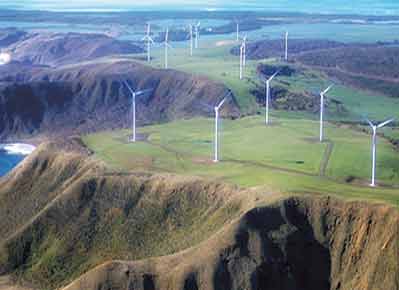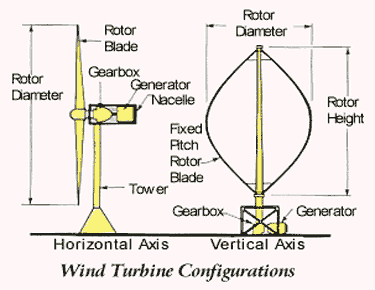Let's Take A Look At
How A Wind Turbine Works
The easiest way to understand how a wind turbine works is to think of a fan operating in reverse.So instead of electricity spinning the blades to generate wind, the wind spins the blades to generate electricity!

If the mechanical energy is used directly, such as to pump water, the machine is most commonly referred to as a windmill.
If the mechanical energy is converted to electricity, the machine is called a wind turbine, wind generator, wind power unit or a wind energy converter.
Basically, they operates as follows:
The wind turns the blades -> the blades spin a shaft -> the shaft connects to a generator -> the generator produces electricity!
For a detailed illustration with a breakdown of the working parts, go and take a look inside a wind turbine!
The turbines are designed to exploit the wind energy that exists at a location. Aerodynamic modeling is used to factor the best tower height, control systems, number of blades, and blade shape.
The turbines are designed to exploit the wind energy that exists at a location. Aerodynamic modeling is used to factor the best tower height, control systems, number of blades, and blade shape.
Modern turbines fall into two basic groups - the horizontal-axis and thevertical-axis "egg beater" design. The following image shows the difference between the two designs.

Turbines will often be classified by the location in which they are to be used. Onshore and offshore are the most widely used classification by location. There are also aerial turbines.
Each class of turbines has unique design characteristics intended to suit their specific location.
The size of a turbine will influence its power generating capacity. The smaller turbines, which produce under 50 kilowatts, are most commonly used to power water pumps, telecommunication dishes, and homes.
Use of wind energy can, on average, reduce energy costs of a home by 50-90%. The range varies greatly, as installations are influenced by a variety of factors and, as such, energy savings can fluctuate greatly.
A 5-15 kilowatt turbine should more than do the job in a home that uses under 10,000 kilowatt hours of electricity per year. This type of system will cost between $6,000-$22,000 to install.
Many factors influence the cost of a residential installation. These include its size, your intended application, and any service contracts you negotiate with the manufacturer.
A hybrid wind systems uses smaller turbines in combination with photovoltaic systems, rechargeable deep-cycle batteries, and diesel generators to provide storable, on-demand power in remote, off-the-grid locations.
There is a growing trend towards building DIY wind turbines for residential application.
Utility-scale turbines range in size from 100 kilowatts to as large as several megawatts. Larger wind turbines are grouped together into wind farms.
Wind farms provide bulk power to the main electricity grid for distribution to the end users - you and me!
There is a chance you're qualified for a new solar energy program.
ReplyDeleteClick here and find out if you're eligble now!